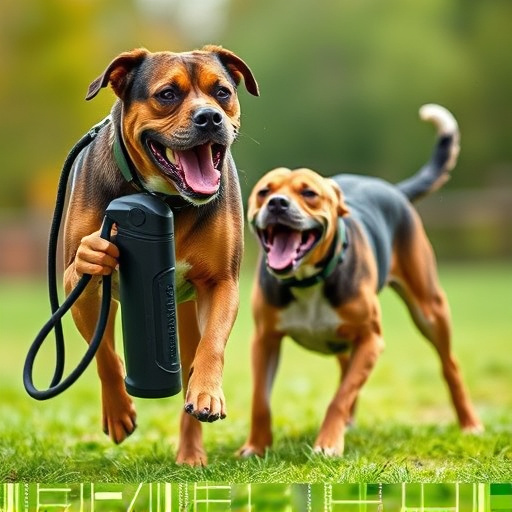Pepper spray for dogs, containing capsaicin, temporarily immobilizes aggressive canines by irritating eyes and nose. Its use is regulated by legal age restrictions (typically 18) to ensure responsible handling, as local laws vary widely. When considering it, prioritize safety, understand its potent nature as a last resort, and explore alternatives like positive reinforcement training or specialized collars.
“Confronting aggressive dog behavior requires a strategic approach, and one tool gaining attention is pepper spray. This article delves into the effectiveness of using pepper spray as a non-lethal deterrent for dogs displaying aggression. We’ll explore ‘Understanding Pepper Spray for Dog Aggression’ and its mechanism, navigate ‘Legal Considerations’ regarding age restrictions and regulations on purchasing dog pepper spray, and uncover ‘Effective Use Cases’ where it can be deployed safely. Additionally, we’ll discuss ‘Safety Precautions and Alternatives’ to ensure responsible handling.”
- Understanding Pepper Spray for Dog Aggression: What It Is and How It Works
- Legal Considerations: Age Restrictions and Regulations on Buying Dog Pepper Spray
- Effective Use Cases: When and How to Deploy Pepper Spray on Aggressive Dogs
- Safety Precautions and Alternatives: Ensuring Safe Handling and Exploring Other Solutions
Understanding Pepper Spray for Dog Aggression: What It Is and How It Works
Pepper spray for dogs is a controversial yet potentially life-saving tool designed to immobilize aggressive canines temporarily. It’s a versatile option for dog owners, trainers, and even law enforcement navigating situations with out-of-control dogs. Understanding its mechanics is crucial when considering its use.
The active ingredient in dog pepper spray is capsaicin, the same compound responsible for the heat sensation in chili peppers. When sprayed into a dog’s eyes and nose, capsaicin irritates these sensitive areas, leading to temporary blindness, tears, and intense discomfort. This disruption triggers a reaction that causes the dog to freeze or retreat, providing an opportunity for safe escape or professional intervention. It’s important to note that legal age restrictions apply when buying dog pepper spray, ensuring responsible use and minimizing risks.
Legal Considerations: Age Restrictions and Regulations on Buying Dog Pepper Spray
Before considering buying dog pepper spray, it’s crucial to familiarize yourself with local laws and age restrictions. The legal age for purchasing such products varies significantly across regions, with some areas permitting purchases only by licensed professionals or individuals enrolled in specialized training programs. These regulations exist to ensure safe handling and responsible use of pepper spray, especially around animals.
Understanding these rules is essential to avoid legal repercussions. Additionally, some regions have specific requirements for storage and disposal, further emphasizing the need for thorough research before buying dog pepper spray. Always consult local authorities or law enforcement agencies to stay informed about current regulations.
Effective Use Cases: When and How to Deploy Pepper Spray on Aggressive Dogs
When it comes to dealing with aggressive dogs, pepper spray can be an effective deterrent and safety measure. It’s crucial to understand the legal age requirements for purchasing dog pepper spray, as this varies by region. In many places, you’ll need to be 18 or older to buy it legally. This is important not just for access but also for ensuring responsible handling.
Deployment should be strategic and immediate. If a dog displays aggressive behavior, like growling, snarling, or charging, pepper spray can be used to temporarily incapacitate the animal enough to safely separate you or others from its path. It’s recommended to aim for the face—between the eyes and nose—for maximum effectiveness. However, always prioritize safety first; ensure you’re at a safe distance and have a clear escape route when using pepper spray on an aggressive dog.
Safety Precautions and Alternatives: Ensuring Safe Handling and Exploring Other Solutions
When considering pepper spray for aggressive dogs, safety precautions are paramount. It’s crucial to understand that pepper spray is a potent irritant and should only be used as a last resort when all other training and behavior modification methods have failed. Ensure you meet the legal age requirements—typically 18 years or older—before purchasing any dog pepper spray. Proper handling is essential; always store it securely out of reach of children and pets, and keep it in its original packaging until needed. Familiarize yourself with local laws regarding the use and possession of pepper spray to avoid legal repercussions.
Exploring alternatives to chemical deterrents can be a safer and more humane approach. Positive reinforcement training, for example, teaches dogs good behavior through rewards, while specialized collars or harnesses can help manage aggression without resorting to irritants. Moreover, providing adequate exercise, mental stimulation, and socialization can significantly reduce aggressive tendencies. Consulting with a professional dog trainer or behaviorist is recommended to find the best solution tailored to your dog’s unique needs.
When considering pepper spray as a deterrent for aggressive dogs, it’s crucial to balance its potential effectiveness with legal age restrictions and safety precautions. Understanding both the regulations regarding the purchase of dog pepper spray and proper usage techniques is essential. While it can be a game-changer in certain situations, it should be one of many tools in your toolbox when dealing with canine aggression, alongside training, behavior modification, and other safe alternatives. Always ensure you’re operating within the law and prioritize the well-being of both your dog and others.
